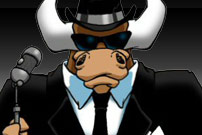 With the temperature dropping, it's time to find someone to keep you warm. Find your hookups with our online dating guide!
With the temperature dropping, it's time to find someone to keep you warm. Find your hookups with our online dating guide!

Entertainment Channel / Bullz-Eye Home
Iron Man, Batman and a certain sexagenarian archaeologist may get the large typeface when it comes to this summer’s movies, but a good chunk of the Bullz-Eye staff was just as geeked – if not more so – for “WALL*E,” Pixar’s latest adventure about the last robot standing on Earth. If the movie is anything like the rest of the movies in Pixar’s near-bulletproof catalog (sorry, we just weren’t that high on “Cars”), little WALL*E is sure to become not only one of our favorite robots of all time, but one of our favorite characters of all time. Which is pretty impressive when you consider that he can’t speak a word of English.
You can see where the train of thought took us from here: who exactly are our favorite robots of all time? After a lengthy debate about the differences between androids and cyborgs, and whether robots played by real actors were eligible – something that even staff geek Will Harris called out as the geekiest conversation he’s ever heard – we got to voting, and in a move that will surprise no one, our libidos played a significant role in determining our favorites. Now where did we put that Kraftwerk CD….
 The Gunslinger
The Gunslinger
"Westworld," 1973
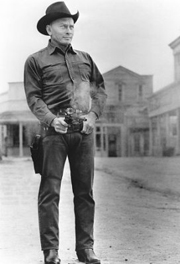 Yul Brynner, mid-century moviedom’s ultimate bald badass, only needed a pair of creepy contact lenses to become one of cinema’s scariest robots. Michael Crichton’s 1973 hit, “Westworld,” brought us Delos, a futuristic amusement park where revelers could live out Hollywood fantasies and enjoy the pleasure of, say, shooting a vicious robotic gunfighter without the slightest risk of dying, or boffing a super-silicon saloon girl without the slightest risk of the clap. As in Crichton’s later “Jurassic Park,” the amusement turns deadly and an unlucky tinhorn of a tourist (Richard Benjamin) finds himself facing an extreme risk of being gut shot by a replica of Brynner’s ultra-stoic mercenary from the 1960 blockbuster “The Magnificent Seven.” Brynner’s chilly minimalism portrays nothing more or less than pure and simple vengeful animatronic bloodlust. It’s fearsome as hell, and a casting coup for the ages. – Bob Westal
Yul Brynner, mid-century moviedom’s ultimate bald badass, only needed a pair of creepy contact lenses to become one of cinema’s scariest robots. Michael Crichton’s 1973 hit, “Westworld,” brought us Delos, a futuristic amusement park where revelers could live out Hollywood fantasies and enjoy the pleasure of, say, shooting a vicious robotic gunfighter without the slightest risk of dying, or boffing a super-silicon saloon girl without the slightest risk of the clap. As in Crichton’s later “Jurassic Park,” the amusement turns deadly and an unlucky tinhorn of a tourist (Richard Benjamin) finds himself facing an extreme risk of being gut shot by a replica of Brynner’s ultra-stoic mercenary from the 1960 blockbuster “The Magnificent Seven.” Brynner’s chilly minimalism portrays nothing more or less than pure and simple vengeful animatronic bloodlust. It’s fearsome as hell, and a casting coup for the ages. – Bob Westal
 Twiki
Twiki
“Buck Rogers in the 25th Century”
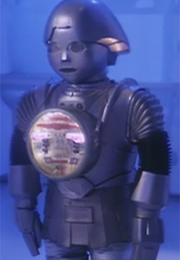 We are well aware that Twiki, an “ambuquad” mining robot from the TV adaption of “Buck Rogers in the 25th Century,” is in fact an abomination to robots across the universe. But how do you assemble a list of robots and not include the lone robot that not only speaks jive, but was voiced by the immortal Mel Blanc? Twiki had one purpose on the show; get the young ‘uns to watch, and get the young ‘uns he did. It was at the expense of everything else in the show, of course, but to be fair, no one was watching “Buck Rogers” for high drama. Our pet theory is that producer Glen Larson lost a bet with the Zucker Brothers, and when it came time for Larson to pay up, the Zuckers said, “Forget the money: put a jive-talking robot in your next show.” Biddi-biddi-biddi makes as much sense as anything. – David Medsker
We are well aware that Twiki, an “ambuquad” mining robot from the TV adaption of “Buck Rogers in the 25th Century,” is in fact an abomination to robots across the universe. But how do you assemble a list of robots and not include the lone robot that not only speaks jive, but was voiced by the immortal Mel Blanc? Twiki had one purpose on the show; get the young ‘uns to watch, and get the young ‘uns he did. It was at the expense of everything else in the show, of course, but to be fair, no one was watching “Buck Rogers” for high drama. Our pet theory is that producer Glen Larson lost a bet with the Zucker Brothers, and when it came time for Larson to pay up, the Zuckers said, “Forget the money: put a jive-talking robot in your next show.” Biddi-biddi-biddi makes as much sense as anything. – David Medsker
 Optimus Prime
Optimus Prime
“Transformers”
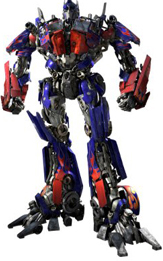 Robots on their own are already pretty cool, but when you make them 20 feet tall, equip them with a giant light saber, and give them the ability to transform into semi-trucks, well, it’s sort of a no-brainer as to how they end up on a list like this. To be fair, you could make a case for any one of the Transformers to be represented here, but there’s no one cooler than Autobots head honcho Optimus Prime. He’s the personification of Awesomeness and has the name to prove it. Sure, his death in the animated Transformers movie may have knocked him down a few spots, and his rebirth in Michael Bay’s live-action rendition came with an extra helping of unwelcome mischievousness (“Oops… Sorry, my bad”), but that hardly matters when you’re the baddest ‘bot on the block. – Jason Zingale
Robots on their own are already pretty cool, but when you make them 20 feet tall, equip them with a giant light saber, and give them the ability to transform into semi-trucks, well, it’s sort of a no-brainer as to how they end up on a list like this. To be fair, you could make a case for any one of the Transformers to be represented here, but there’s no one cooler than Autobots head honcho Optimus Prime. He’s the personification of Awesomeness and has the name to prove it. Sure, his death in the animated Transformers movie may have knocked him down a few spots, and his rebirth in Michael Bay’s live-action rendition came with an extra helping of unwelcome mischievousness (“Oops… Sorry, my bad”), but that hardly matters when you’re the baddest ‘bot on the block. – Jason Zingale
 Terminator Model T-1000
Terminator Model T-1000
“Terminator 2: Judgment Day”
An advanced version of the original Terminator, the T-1000 might not be as persistent as his low-tech counterpart, but he’s certainly more impressive. His liquid metal composition allows for some pretty nifty tricks (like shape shifting, fitting through cracks, or walking through prison bars), while his ability to absorb damage makes him even that much harder to destroy. With those kinds of advantages, you’d think the T-1000 would just mow through his opposition, but he’s surprisingly non-violent, opting instead to use deception over brute force. Of course, when that doesn’t work, he’s more than willing to show off the goods – like when he spouts two additional hands to fire automatic guns while tracking the Connors through Skynet in a helicopter. Hmmm, now that we think of it, maybe he is the more persistent one. – JZ
 Gort
Gort
“The Day the Earth Stood Still,” 1951
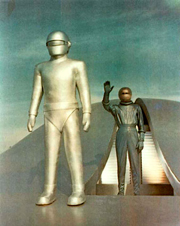 Though little more than a two-part suit with a very large actor inside, Gort is known to fans of the subtly political 1951 classic, “The Day the Earth Stood Still” as the robot/superduper space sentry and companion to Klatu (Michael Rennie), the charismatic alien visitor who befriends beautiful Patricia Neal and her son while taking on Washington. Portrayed by Lock Martin, a somewhat frail actor and Grauman’s Chinese Theater doorman believed to be as tall as 7-foot-7, Gort’s movements are slow but extremely confident – and the annihilating ray that the machine occasionally uses to dispatch tanks and other weaponry doesn’t hurt, either. That impression of raw power is crucial because the three little words that make up the film’s best-known piece of dialogue, “Klatu borada nikto!” roughly translate as “Klatu respectfully requests that you please not destroy the Earth.” – BW
Though little more than a two-part suit with a very large actor inside, Gort is known to fans of the subtly political 1951 classic, “The Day the Earth Stood Still” as the robot/superduper space sentry and companion to Klatu (Michael Rennie), the charismatic alien visitor who befriends beautiful Patricia Neal and her son while taking on Washington. Portrayed by Lock Martin, a somewhat frail actor and Grauman’s Chinese Theater doorman believed to be as tall as 7-foot-7, Gort’s movements are slow but extremely confident – and the annihilating ray that the machine occasionally uses to dispatch tanks and other weaponry doesn’t hurt, either. That impression of raw power is crucial because the three little words that make up the film’s best-known piece of dialogue, “Klatu borada nikto!” roughly translate as “Klatu respectfully requests that you please not destroy the Earth.” – BW
 Robby the Robot
Robby the Robot
“The Forbidden Planet,” 1956
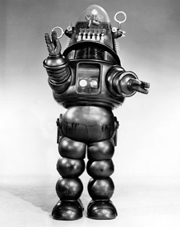 In 1956, “Forbidden Planet” was the last word in cinematic space opera, and Robby was definitely the last word in robots. Complete with gee-whiz thingamabobs, and accordion-style arms that expressively flailed about, he was actually modeled on Ariel, the powerful wood sprite from Shakespeare’s “The Tempest.” Essentially a flunky for Walter Pidgeon’s super-scientist and his innocently sexy daughter (Anne Francis), he nevertheless managed to upstage the human cast (including a young Leslie Nielsen) and a star was born. Eventually, designer Robert Kinoshita created an arguably more famous cousin for the “Lost in Space” television series. Robby himself has enjoyed probably the longest career of any showbiz automaton, appearing in more than 30 productions, ranging from three episodes of the original “Twilight Zone” to a 1981 commercial for Charmin toilet paper, to 1984’s “Gremlins” and 1999’s “Star Wars: Episode I.” Five decades after his debut, Robby remains the ultimate Hollywood robot. – BW
In 1956, “Forbidden Planet” was the last word in cinematic space opera, and Robby was definitely the last word in robots. Complete with gee-whiz thingamabobs, and accordion-style arms that expressively flailed about, he was actually modeled on Ariel, the powerful wood sprite from Shakespeare’s “The Tempest.” Essentially a flunky for Walter Pidgeon’s super-scientist and his innocently sexy daughter (Anne Francis), he nevertheless managed to upstage the human cast (including a young Leslie Nielsen) and a star was born. Eventually, designer Robert Kinoshita created an arguably more famous cousin for the “Lost in Space” television series. Robby himself has enjoyed probably the longest career of any showbiz automaton, appearing in more than 30 productions, ranging from three episodes of the original “Twilight Zone” to a 1981 commercial for Charmin toilet paper, to 1984’s “Gremlins” and 1999’s “Star Wars: Episode I.” Five decades after his debut, Robby remains the ultimate Hollywood robot. – BW
 Hayden Christensen
Hayden Christensen
Well, do you have a better explanation for his acting?
– DM
 R2D2
R2D2
“Star Wars”
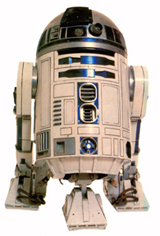 If C3PO were played by Chris Farley in an alternate universe, then you’d likely find David Spade crouched inside an R2-D2 unit right next to him. The straight man (in more ways than one) of the Laurel & Hardy-esque comic relief of “Star Wars,” R2-D2 may be impossible to understand, but he’s the more tolerable of the robotic duo. In fact, he’s actually quite cute and perky – especially when he’s helping save the world – and though his circuits have been fried more times than we’d care to count, he’s remained a reliable ally throughout. One of only a handful of characters to appear in all six “Star Wars” films, R2-D2 has also served three different members of the Skywalker family (Queen Amidala, Anakin and Luke), and was the first of two fictional robots to be inducted into the Robot Hall of Fame. Quite the résumé, if you ask us. – JZ
If C3PO were played by Chris Farley in an alternate universe, then you’d likely find David Spade crouched inside an R2-D2 unit right next to him. The straight man (in more ways than one) of the Laurel & Hardy-esque comic relief of “Star Wars,” R2-D2 may be impossible to understand, but he’s the more tolerable of the robotic duo. In fact, he’s actually quite cute and perky – especially when he’s helping save the world – and though his circuits have been fried more times than we’d care to count, he’s remained a reliable ally throughout. One of only a handful of characters to appear in all six “Star Wars” films, R2-D2 has also served three different members of the Skywalker family (Queen Amidala, Anakin and Luke), and was the first of two fictional robots to be inducted into the Robot Hall of Fame. Quite the résumé, if you ask us. – JZ
 Cameron Phillips (Terminator, model # unknown)
Cameron Phillips (Terminator, model # unknown)
“Terminator: The Sarah Connor Chronicles”
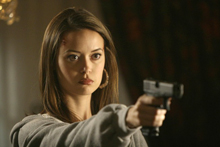 We were already crazy for Summer Glau from her days as the “Firefly”/”Serenity” killing machine River Tam. When the staff was asked if they had any questions for her on an upcoming conference call, one staffer said, “Will you marry me?” But the idea of her playing a Terminator is cool beyond cool. As Troy McClure once said, it’s the part she was born to play, baby! She is the most petite Terminator to date, yet from the looks of it, she is also the most dangerous, easily dispensing of Terminators twice her size. What makes Cameron so intriguing, though, is her rather human ability to overrule her own programming to accept some commands and refuse others. She also seems genuinely curious about human emotion, and the concepts of art, love and loss. Combine this with John Connor’s genuine affection for her, and it’s quite possible that John may have some digital love in his future. Lucky bastard. – DM
We were already crazy for Summer Glau from her days as the “Firefly”/”Serenity” killing machine River Tam. When the staff was asked if they had any questions for her on an upcoming conference call, one staffer said, “Will you marry me?” But the idea of her playing a Terminator is cool beyond cool. As Troy McClure once said, it’s the part she was born to play, baby! She is the most petite Terminator to date, yet from the looks of it, she is also the most dangerous, easily dispensing of Terminators twice her size. What makes Cameron so intriguing, though, is her rather human ability to overrule her own programming to accept some commands and refuse others. She also seems genuinely curious about human emotion, and the concepts of art, love and loss. Combine this with John Connor’s genuine affection for her, and it’s quite possible that John may have some digital love in his future. Lucky bastard. – DM
 Mecha-Streisand
Mecha-Streisand
“South Park”
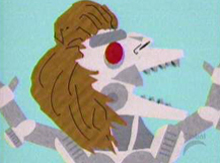 We knew it all along. Babs was never just a singer/actress/director/ meaningless hyphenate collector but a dark soul who would stop at nothing to restore the Diamond of Pantheos, even if it means torturing children to achieve her goal (which she does, by singing to them). Once she accomplishes her fiendish goal, the power unleashed by the diamond turns Barbra into the most diabolical monster the world has ever known. The only thing that stopped Mecha-Streisand short of world domination was a well-placed jab to the nose by the Cure’s Robert Smith, who dislodged the Diamond and sent Mecha-Streisand hurtling through space, where she no doubt continues to torment any asteroid or planet unfortunate enough to cross her path. In some cultures, it is believed that Mecha-Streisand is used as a Keyser Soze-type bogeyman story. Eat your vegetables, or Mecha-Streisand will get you. That would be enough to scare us straight. – DM
We knew it all along. Babs was never just a singer/actress/director/ meaningless hyphenate collector but a dark soul who would stop at nothing to restore the Diamond of Pantheos, even if it means torturing children to achieve her goal (which she does, by singing to them). Once she accomplishes her fiendish goal, the power unleashed by the diamond turns Barbra into the most diabolical monster the world has ever known. The only thing that stopped Mecha-Streisand short of world domination was a well-placed jab to the nose by the Cure’s Robert Smith, who dislodged the Diamond and sent Mecha-Streisand hurtling through space, where she no doubt continues to torment any asteroid or planet unfortunate enough to cross her path. In some cultures, it is believed that Mecha-Streisand is used as a Keyser Soze-type bogeyman story. Eat your vegetables, or Mecha-Streisand will get you. That would be enough to scare us straight. – DM
 Buffybot
Buffybot
“Buffy the Vampire Slayer”
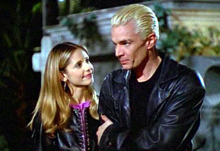 The idea of a robot equivalent of Sarah Michelle Gellar is already awesome, but when you consider the original reason for her creation – to serve as the submissive sex toy for lovestruck vampire Spike – now we’re talking a completely different kind of awesome. Who wouldn’t want their own Buffybot? Of course, Spike’s jig was up almost as soon as it began, and when Buffy dies (again) at the end of Season Five, Buffybot is reprogrammed and put into the field in order to keep the vampire populace from going on a feeding frenzy. This is where Buffybot goes from awesome to super-awesome: her mannerisms are a tad off, which leads to some embarrassing but funny commentary. When Buffybot sees Willow, she tells her, “You’re recently gay,” as if Willow herself were unaware of this. The best line, though, is when Buffybot meets the real Buffy, and says, “Hey, you look just like me! We’re very pretty.” We couldn’t agree more. – DM
The idea of a robot equivalent of Sarah Michelle Gellar is already awesome, but when you consider the original reason for her creation – to serve as the submissive sex toy for lovestruck vampire Spike – now we’re talking a completely different kind of awesome. Who wouldn’t want their own Buffybot? Of course, Spike’s jig was up almost as soon as it began, and when Buffy dies (again) at the end of Season Five, Buffybot is reprogrammed and put into the field in order to keep the vampire populace from going on a feeding frenzy. This is where Buffybot goes from awesome to super-awesome: her mannerisms are a tad off, which leads to some embarrassing but funny commentary. When Buffybot sees Willow, she tells her, “You’re recently gay,” as if Willow herself were unaware of this. The best line, though, is when Buffybot meets the real Buffy, and says, “Hey, you look just like me! We’re very pretty.” We couldn’t agree more. – DM
 Hymie the Robot
Hymie the Robot
“Get Smart”
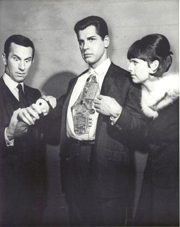 Although he ended up working alongside Maxwell Smart as one of CONTROL’s top agents, Hymie the Robot – played by Dick Gautier – was originally playing for the other side. KAOS spent a cool million on his development and creation, but Max managed to sway him over to the side of good, and Hymie’s been one of CONTROL’s top agents ever since. (Well, actually, he originally wanted to join IBM to meet some nice machines, but he eventually changed his mind.) His top-secret file reveals that he weighs 982 pounds and has an IQ of over 200, but even with all of that intelligence, he’s still prone to taking commands like “knock it off” literally. He easily makes up for his naïveté, however, with abilities like being able to analyze any substance by tasting it and having a built-in copy machine, TV camera, and calculator. In the original series, Max is Hymie’s best friend, and if the reverse isn’t true, they’re still close enough that Hymie was in the running to be the best man at Max’s wedding. There’s no official word on how much of a role Hymie will play in this summer’s “Get Smart” movie, but just knowing that he’ll be played by Patrick Warburton is enough for us to get excited at the prospects. – Will Harris
Although he ended up working alongside Maxwell Smart as one of CONTROL’s top agents, Hymie the Robot – played by Dick Gautier – was originally playing for the other side. KAOS spent a cool million on his development and creation, but Max managed to sway him over to the side of good, and Hymie’s been one of CONTROL’s top agents ever since. (Well, actually, he originally wanted to join IBM to meet some nice machines, but he eventually changed his mind.) His top-secret file reveals that he weighs 982 pounds and has an IQ of over 200, but even with all of that intelligence, he’s still prone to taking commands like “knock it off” literally. He easily makes up for his naïveté, however, with abilities like being able to analyze any substance by tasting it and having a built-in copy machine, TV camera, and calculator. In the original series, Max is Hymie’s best friend, and if the reverse isn’t true, they’re still close enough that Hymie was in the running to be the best man at Max’s wedding. There’s no official word on how much of a role Hymie will play in this summer’s “Get Smart” movie, but just knowing that he’ll be played by Patrick Warburton is enough for us to get excited at the prospects. – Will Harris
 Crow T. Robot
Crow T. Robot
“Mystery Science Theater 3000”
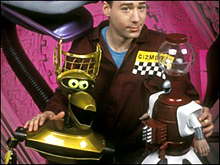 In a not-too-distant future…no, never mind, we can’t bring ourselves to sing the whole theme song. Let’s just cut to the chase: Joel Robinson was shot into space and trapped on the Satellite of Love, where he was forced to watch bad movies, and rather than suffer solo, he built himself a few robot companions, including Cambot, Gypsy, Tom Servo and Crrrooowww T. Robot. Crow’s accomplishments on the Satellite are wide and varied, but while he can take great pride in having written the screenplays for “Earth vs. Soup” and “Chocolate Jones and the Temple of Funk,” surely his greatest achievement is the composition of the moving holiday standard, “Let’s Have a Patrick Swayze Christmas.” Even with lyrics like, “It's my way or the highway, this Christmas at my bar / I'll have to smash your kneecaps if you bastards touch my car,” you have to admit: for a ‘bot with ping-pong ball eyes and a split plastic bowling bin for a mouth, it ain’t half bad. – WH
In a not-too-distant future…no, never mind, we can’t bring ourselves to sing the whole theme song. Let’s just cut to the chase: Joel Robinson was shot into space and trapped on the Satellite of Love, where he was forced to watch bad movies, and rather than suffer solo, he built himself a few robot companions, including Cambot, Gypsy, Tom Servo and Crrrooowww T. Robot. Crow’s accomplishments on the Satellite are wide and varied, but while he can take great pride in having written the screenplays for “Earth vs. Soup” and “Chocolate Jones and the Temple of Funk,” surely his greatest achievement is the composition of the moving holiday standard, “Let’s Have a Patrick Swayze Christmas.” Even with lyrics like, “It's my way or the highway, this Christmas at my bar / I'll have to smash your kneecaps if you bastards touch my car,” you have to admit: for a ‘bot with ping-pong ball eyes and a split plastic bowling bin for a mouth, it ain’t half bad. – WH
 The Cylons
The Cylons
“Battlestar Galactica,” 1978, 2004
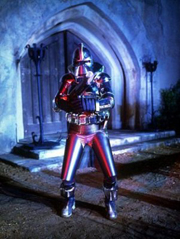 Depending on which series you believe, Cylons are robots constructed by a once-powerful lizard race (in the original 1978 series) or the colonial humans themselves (in the 2004 re-imagining). Either way, they’re pretty badass. In the original series, they were cold, unemotional creatures with one mission – kill the humans. In the re-imagining, they take on two forms. First, there are the Centurions, which are the workers and soldiers of the Cylon race. They resemble the Cylons from the original series, but they are bigger and far more formidable. Then there are the Cylons who are virtually indistinguishable from humans. Not only do they use brute force (i.e. nuclear bombs) in their war against the humans, they also manage to infiltrate the highest levels of the refugee human fleet. But these “skinjobs” can feel emotion and they’re not all as cold or callous as their mechanical counterparts. This complexity and mystery gives the re-imagining a whole different flavor, as the Cylons’ true motives are that much more difficult to figure out. – John Paulsen
Depending on which series you believe, Cylons are robots constructed by a once-powerful lizard race (in the original 1978 series) or the colonial humans themselves (in the 2004 re-imagining). Either way, they’re pretty badass. In the original series, they were cold, unemotional creatures with one mission – kill the humans. In the re-imagining, they take on two forms. First, there are the Centurions, which are the workers and soldiers of the Cylon race. They resemble the Cylons from the original series, but they are bigger and far more formidable. Then there are the Cylons who are virtually indistinguishable from humans. Not only do they use brute force (i.e. nuclear bombs) in their war against the humans, they also manage to infiltrate the highest levels of the refugee human fleet. But these “skinjobs” can feel emotion and they’re not all as cold or callous as their mechanical counterparts. This complexity and mystery gives the re-imagining a whole different flavor, as the Cylons’ true motives are that much more difficult to figure out. – John Paulsen
 The Iron Giant
The Iron Giant
“The Iron Giant,” 1999
 Hang on, let us get the tissues before we start up with this entry. Don’t worry, we won’t be offering any major spoilers about the title character of Brad Bird’s 1999 animated classic, since someone on the staff – cough, David Medsker, cough – still hasn’t seen it. We’re not giving anything away, though, to say that few robots can match the size of The Iron Giant’s heart. He came out of the sky, arriving from parts unknown, but after a close encounter with an electric power plant, the Giant is saved from electrocution by a young lad named Hogarth. Despite their significant differences in height, the unlikely pair forms a strong bond of friendship, one which is soon challenged by those who view the Giant as little more than a gargantuan weapon. In the end, the Giant proves otherwise…but at what cost? Sorry, can’t say. But as we wipe a tear from our eye, we will at least offer the sage advice that young Hogarth passed on to his friend: you are who you choose to be. Oh, damn it, there go the waterworks.
Hang on, let us get the tissues before we start up with this entry. Don’t worry, we won’t be offering any major spoilers about the title character of Brad Bird’s 1999 animated classic, since someone on the staff – cough, David Medsker, cough – still hasn’t seen it. We’re not giving anything away, though, to say that few robots can match the size of The Iron Giant’s heart. He came out of the sky, arriving from parts unknown, but after a close encounter with an electric power plant, the Giant is saved from electrocution by a young lad named Hogarth. Despite their significant differences in height, the unlikely pair forms a strong bond of friendship, one which is soon challenged by those who view the Giant as little more than a gargantuan weapon. In the end, the Giant proves otherwise…but at what cost? Sorry, can’t say. But as we wipe a tear from our eye, we will at least offer the sage advice that young Hogarth passed on to his friend: you are who you choose to be. Oh, damn it, there go the waterworks.
– WH
 Terminator Series 800
Terminator Series 800
Model 101, “The Terminator”
 Arnold Schwarzenegger’s career-defining role as The Terminator made such a large dent in the pop culture world that it’s the only character to appear on AFI’s lists for greatest heroes and villains. You’ve gotta love when the cold-hearted assassin turns good, but while the kinder, gentler Terminator from the sequels is certainly the more popular version, we still hold a special place in our hearts for the T-101 (or T-800, depending on whom you ask) from the original film. Sent back in time to kill the mother of future resistance leader John Connor, the Terminator is not only an indestructible killing machine – he’s what director James Cameron calls “death rendered in steel.” And to think O.J. Simpson wasn’t given the part because Cameron didn’t think such a nice guy could play a ruthless killer. – JZ
Arnold Schwarzenegger’s career-defining role as The Terminator made such a large dent in the pop culture world that it’s the only character to appear on AFI’s lists for greatest heroes and villains. You’ve gotta love when the cold-hearted assassin turns good, but while the kinder, gentler Terminator from the sequels is certainly the more popular version, we still hold a special place in our hearts for the T-101 (or T-800, depending on whom you ask) from the original film. Sent back in time to kill the mother of future resistance leader John Connor, the Terminator is not only an indestructible killing machine – he’s what director James Cameron calls “death rendered in steel.” And to think O.J. Simpson wasn’t given the part because Cameron didn’t think such a nice guy could play a ruthless killer. – JZ
 Marvin, the Paranoid Android
Marvin, the Paranoid Android
“The Hitchhiker’s Guide to the Galaxy”
 We think you ought to know that Marvin’s feeling very depressed…but, then, what would you expect from a robot who has a brain the size of a planet but whose most elaborate assignment is to take guests from one location to another? Marvin was constructed by the Sirius Cybernetics Corporation completely against his will, observing, “I didn't ask to be made. No one consulted me or considered my feelings in the matter.” As the designated menial laborer on the spaceship Heart of Gold, Marvin is assigned plenty of tasks beneath his intelligence, but the most boring occurs when he ends up spending precisely 576,000,003,579 years on the surface of the planet Magrathea. (“The first 10 million years were the worst, and the second 10 million years, they were the worst, too. The third 10 million I didn't enjoy at all. After that, I went into a bit of a decline.”) Though Alan Rickman did a fine job of voicing the character in the film version of “Hitchhiker’s,” the definitive voice of Marvin will always be Stephen Moore, who took the android into the British pop charts in 1981 by providing him with his very own theme song. – WH
We think you ought to know that Marvin’s feeling very depressed…but, then, what would you expect from a robot who has a brain the size of a planet but whose most elaborate assignment is to take guests from one location to another? Marvin was constructed by the Sirius Cybernetics Corporation completely against his will, observing, “I didn't ask to be made. No one consulted me or considered my feelings in the matter.” As the designated menial laborer on the spaceship Heart of Gold, Marvin is assigned plenty of tasks beneath his intelligence, but the most boring occurs when he ends up spending precisely 576,000,003,579 years on the surface of the planet Magrathea. (“The first 10 million years were the worst, and the second 10 million years, they were the worst, too. The third 10 million I didn't enjoy at all. After that, I went into a bit of a decline.”) Though Alan Rickman did a fine job of voicing the character in the film version of “Hitchhiker’s,” the definitive voice of Marvin will always be Stephen Moore, who took the android into the British pop charts in 1981 by providing him with his very own theme song. – WH
 Data
Data
“Star Trek: The Next Generation”
 Starfleet’s first android officer evolved considerably over the course of the seven seasons of “Star Trek: The Next Generation.” He started out as little more than a Spock replacement – no emotion, all intellect, totally flummoxed by humanity – but as he was fleshed out in episodes like “Measure of a Man,” where he was determined to have the right to self-determination. He became a character who was arguably better developed than some of the living beings on the series. Hell, he even learned stand-up comedy from Joe Piscopo! In the subsequent “ST:TNG” films, Data plugged an emotion chip into his positronic brain and gained the ability to laugh, cry and all that other good stuff, but all told, we prefer the original model. Oh, and if you’re wondering, the preferred pronunciation of his name is “day-ta.” Someone once called him “dat-tuh,” and when he corrected them, they asked, “What’s the difference?” “One is my name,” he replied. “The other is not.” Who says androids don’t have a sense of humor? – WH
Starfleet’s first android officer evolved considerably over the course of the seven seasons of “Star Trek: The Next Generation.” He started out as little more than a Spock replacement – no emotion, all intellect, totally flummoxed by humanity – but as he was fleshed out in episodes like “Measure of a Man,” where he was determined to have the right to self-determination. He became a character who was arguably better developed than some of the living beings on the series. Hell, he even learned stand-up comedy from Joe Piscopo! In the subsequent “ST:TNG” films, Data plugged an emotion chip into his positronic brain and gained the ability to laugh, cry and all that other good stuff, but all told, we prefer the original model. Oh, and if you’re wondering, the preferred pronunciation of his name is “day-ta.” Someone once called him “dat-tuh,” and when he corrected them, they asked, “What’s the difference?” “One is my name,” he replied. “The other is not.” Who says androids don’t have a sense of humor? – WH
 Bishop
Bishop
“Aliens”
 Although the crew of the Colonial Marine vessel Sulaco call him a synthetic, Bishop himself prefers the term “artificial person.” But whatever term you prefer, one thing’s for certain: the guy can kick some serious ass at mumblety peg. Bishop has to overcome a lot to gain the trust of Ellen Ripley, due to some unfortunate experiences with the last “artificial person” she had to deal with, but Bishop’s no Ash, assuring her that his programming does not permit him to directly harm or let any harm come to a human being through his own inaction. To prove it, he saves Ripley’s life, as well as that of little Newt...and for his trouble, he gets ripped in half by the Alien queen. Yes, he managed to pull through long enough to score a cameo in “Alien 3,” but can you really consider that a reward?
Although the crew of the Colonial Marine vessel Sulaco call him a synthetic, Bishop himself prefers the term “artificial person.” But whatever term you prefer, one thing’s for certain: the guy can kick some serious ass at mumblety peg. Bishop has to overcome a lot to gain the trust of Ellen Ripley, due to some unfortunate experiences with the last “artificial person” she had to deal with, but Bishop’s no Ash, assuring her that his programming does not permit him to directly harm or let any harm come to a human being through his own inaction. To prove it, he saves Ripley’s life, as well as that of little Newt...and for his trouble, he gets ripped in half by the Alien queen. Yes, he managed to pull through long enough to score a cameo in “Alien 3,” but can you really consider that a reward?
– WH
 Bender
Bender
“Futurama”
 This is all you need to know about the cigar-chomping, Ye Olde Fortran-swilling Bender Bending Rodriguez (made in Tijuana, “America’s Heartland”): he was once fitted with a bomb that would detonate when he uttered the word “ass” (the over/under on that word leaving his sound card at any given moment is roughly 15 seconds). When his co-workers at Planet Express cannot disable the bomb, but find a way to reprogram the trigger word with what they think is the last word that Bender would ever say, he tries to guess the word, even though it would mean instant death for himself and everyone around him. That is the essence of Bender: he’s the robot equivalent of a pre-rehab Robert Downey Jr., self-destructive and careless, yet strangely loveable at the same time. Even when he’s stealing your wallet – and he will steal your wallet – you want to pinch his shiny metal cheeks while he’s doing it. That’s as anti-hero as robots get, and it is to the immense credit of the “Futurama” writing staff that they were able to make someone so morally bankrupt so likable. By the way, you might want to take extra care of who’s around you the next time you say “antiquing.” – DM
This is all you need to know about the cigar-chomping, Ye Olde Fortran-swilling Bender Bending Rodriguez (made in Tijuana, “America’s Heartland”): he was once fitted with a bomb that would detonate when he uttered the word “ass” (the over/under on that word leaving his sound card at any given moment is roughly 15 seconds). When his co-workers at Planet Express cannot disable the bomb, but find a way to reprogram the trigger word with what they think is the last word that Bender would ever say, he tries to guess the word, even though it would mean instant death for himself and everyone around him. That is the essence of Bender: he’s the robot equivalent of a pre-rehab Robert Downey Jr., self-destructive and careless, yet strangely loveable at the same time. Even when he’s stealing your wallet – and he will steal your wallet – you want to pinch his shiny metal cheeks while he’s doing it. That’s as anti-hero as robots get, and it is to the immense credit of the “Futurama” writing staff that they were able to make someone so morally bankrupt so likable. By the way, you might want to take extra care of who’s around you the next time you say “antiquing.” – DM
Honorable Mentions:
Number 5 (“Short Circuit”): That’s Johnny 5 to you, pal, and not only is he alive, but he also looks a hell of a lot like Wall*E.
Robot (“Lost in Space”): We’re not sure if his name is incredibly lazy or brilliantly on-the-nose, but even though Dr. Smith might disagree, personally, we love the way he says, “Danger, Will Robinson!”
Dynomutt (“Dynomutt: Dog Wonder”): He’s fearless, scareless, and perhaps a little too careless, but he’s definitely still a go-go dog person…whatever the hell that means.
Rosie the Robot (“The Jetsons”): The fact that she pays tribute to an earlier TV maid (Hazel) may be lost on current viewers, but she still cleans a mean house.
K-9 (“Doctor Who”): Despite resembling a toolbox with a snout, ears, and a tail, he was the Doctor’s trusted companion for many an adventure.
Bubo (“Clash of the Titans”): Of all the mechanical owls, he’s the…wait, actually, he is all of the mechanical owls!
Astro Boy (“Astro Boy”): One of the earliest of TV’s animated robots (thank you, Japan!), he’s getting his own feature-length film in 2009, so count on a major comeback.
Gigantor (“Gigantor”): He’s a space-age robot and he’s at your command. ‘Nuff said.
You can follow us on Twitter and Facebook for content updates. Also, sign up for our email list for weekly updates and check us out on Google+ as well.
